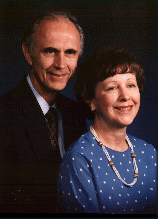Robert Hoffman, Project Scientist for Polar
Marriage is a balancing act. It requires that a person balance self-interest and a spouse's needs, career paths and family life, blood relations and in-law interactions. Working as a project scientist requires the same sense of balance and diplomacy.
Bob Hoffman would know. Thirty-eight years ago, he wed his wife, Barbara, and NASA in the same month. He remains married to both.
On August 1, 1959, Barbara and Bob Hoffman exchanged vows in Minnesota and prepared for a honeymoon
 in Florid1a">
in Florida. Within a few days, the
newlyweds were flying south to a
pristine and sparsely populated beach along the East Coast . . . Cape
Canaveral. The
excitement of a new life together was bound together with the excitement
of participating in
one of NASA's first satellite missions. Business and pleasure were
mixed on a trip that
included three hours of work each day in preparation for the launch of
an experiment on the
Explorer 6 satellite, the ninth ever launched by the United States. As
a graduate student
who helped J.R. Winckler of the University of Minnesota to design and
build a Geiger
counter and ion chamber for the satellite, Hoffman saw the trip as a
chance to launch two
wonderful relationships.
in Florid1a">
in Florida. Within a few days, the
newlyweds were flying south to a
pristine and sparsely populated beach along the East Coast . . . Cape
Canaveral. The
excitement of a new life together was bound together with the excitement
of participating in
one of NASA's first satellite missions. Business and pleasure were
mixed on a trip that
included three hours of work each day in preparation for the launch of
an experiment on the
Explorer 6 satellite, the ninth ever launched by the United States. As
a graduate student
who helped J.R. Winckler of the University of Minnesota to design and
build a Geiger
counter and ion chamber for the satellite, Hoffman saw the trip as a
chance to launch two
wonderful relationships.The Explorer data eventually became a doctoral thesis, and by 1961, Hoffman landed at Goddard Space Flight Center. In 36 years in Greenbelt (plus five in graduate school), he designed instruments for Explorer 6, Pioneer 5, Explorer 12, Orbiting Geophysical Observatories 2 and 4, Explorer 45, Atmosphere Explorers C and D, PegSat, and Dynamics Explorer. As a principal investigator for AE-C, Hoffman had the distinction of working on the same team with his brother, atmospheric scientist John Hoffman of the University of Texas at Dallas. It marked one of the only--if not the only--time that a pair of siblings have flown their own instruments on the same spacecraft (Bob built a low-energy electron detector, John a magnetic ion mass spectrometer).
But perhaps more important than his scientific work is Bob Hoffman's leadership role in space physics at Goddard. He has served as the project scientist for four missions, including the Small Scientific Satellite (later renamed Explorer 45), Dynamics Explorer, PegSat, and Polar, NASA's current mission to study the energy and particles pouring from the solar wind into Earth's upper atmosphere. Official NASA policy states that a project scientist must manage the science team, act as an advisor to the project manager, be the spokesman for the project, and serve as the emissary between investigators and mission operations teams. The project scientist has little official authority, but bears the weight of responsibility for the scientific success of a mission.
To be done well, the job requires a peculiar blend of scientist and engineer, notes Mario Acuna, project scientist for the International Solar-Terrestrial Physics program, of which Polar is a part. Acuna was looking for just such a blend when he asked Hoffman to lead Polar. "No one else was as qualified as Bob," Acuna says. "He has the knowledge of Polar's science, he is well-respected by the magnetospheric physics community, and he has years of experience with DE and other missions."
After Acuna offered the job to Hoffman for a third time--and scientists such as Jim Slavin of Goddard's Electrodynamics Branch and Lou Frank of the University of Iowa called on his sense of duty--he took control of Polar in 1995. He oversaw a successful launch in February 1996 and has distinguished himself as an ambassador for the program and a hands-on protector of the interests of his science team. He has also managed to keep 11 principal investigators and a staff of busy spacecraft operators relatively happy.
And, happily, his bride still loves him, too.
Brought to you by the International Solar-Terrestrial Physics Program and NASA.
Web Development: Sandy Kopman (skopman@pop600.gsfc.nasa.gov)
Author: Mike Carlowicz (mcarlowi@pop600.gsfc.nasa.gov)
Official NASA Contact: Mr. William Mish (wmish@istp1.gsfc.nasa.gov)
/ NASA Home /
Goddard Space Flight Center Home
/
Last Updated: 9/02/97


